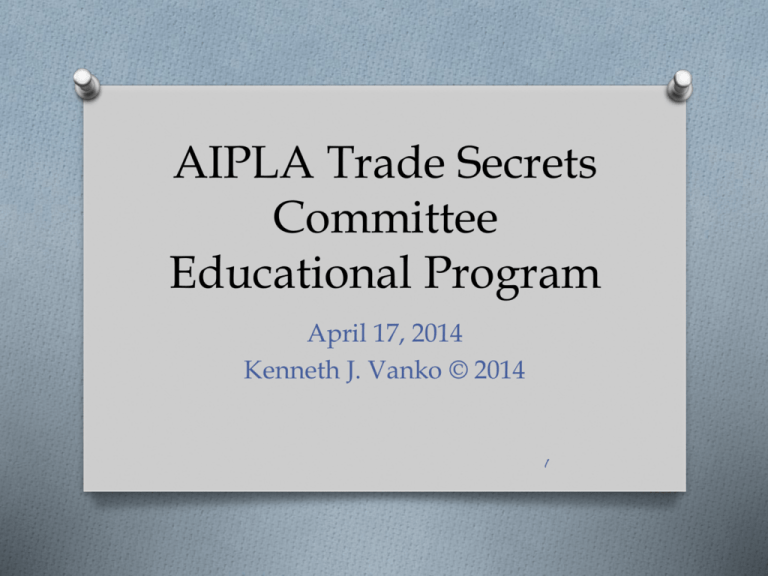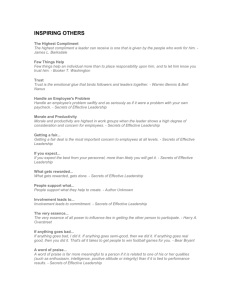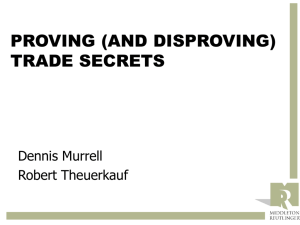April 17 2014 (Kenneth Vanko)
advertisement

AIPLA Trade Secrets Committee Educational Program April 17, 2014 Kenneth J. Vanko © 2014 1 Key Procedural Issues O Topic 1: Identification of trade secrets (35 minutes) O Topic 2: Form and scope of injunction orders (15 minutes) O Questions (10 minutes) 2 Trade Secrets Identification O Basic Problem: O How can a court determine whether an item is a trade secret without first determining what it is the plaintiff claims as a secret? 3 Trade Secrets Identification O Identification considerations for the plaintiff O Finding most knowledgeable persons/key witnesses to address the identification problem O Assessing the potential value of secrets O Determining what the trade secrets list will look like 4 Trade Secrets Identification O Identification considerations for the defendant O Evaluating scope of trade secrets from the complaint O Initial pleading strategy – answer or dismiss? O Pre-discovery identification motion O Appropriately tailor discovery to get solid list of secrets 5 Trade Secrets Identification O When does the identification issue arise? O Pleading stage O Pre-discovery O Discovery (throughout the case) O Summary judgment 6 Trade Secrets Identification O Principle 1: A trade secret plaintiff must identify its alleged trade secrets “with a reasonable degree of precision and specificity” that is “particular enough as to separate the trade secret from matters of general knowledge in the trade or of special knowledge of persons skilled in the trade.” Dow Chem. Canada, Inc. v. HRD Corp., 909 F. Supp. 2d 340, 346 (D. Del. 2012). 7 Trade Secrets Identification O Principle 2: “[G]eneral allegations and generic references to products or information are insufficient to satisfy the reasonable particularity standard.” L-3 Comms. Corp. v. Jaxon Eng’g & Maint., Inc., 2011 U.S. Dist. LEXIS 117757 at *5 (D. Colo. Oct. 12, 2011). 8 Trade Secrets Information O Principle 3: Courts routinely obligate plaintiffs identifying their trade secrets to define them with more particularity before trial on a misappropriation claim. Synygy, Inc. v. ZS Assocs., Inc., 2013 U.S. Dist. LEXIS 98656 (E.D. Pa. July 15, 2013). 9 Trade Secrets Identification O Complaint O General rules O General references to trade secrets usually permitted (Rule 12(b)(6) motions) O Twombly and Iqbal require claim to meet “plausibility” standard O Acceptable: Generalized descriptions of actual secrets O Unacceptable: Broad categories of information 10 Trade Secrets Identification O Example of basis for dismissal order (non- published case) O Trade secrets defined as information about 1,000-plus customers including “pricing, product line profit and loss, material costing, proprietary product designs, part weights, substrate detail, financial data, human resources information, and key customer financials.” O Basis for granting motion to dismiss 11 Trade Secrets Identification O Recent example of sufficient identification in a complaint O nexTune, Inc. v. McKinney, 2013 U.S. Dist. LEXIS 133003 (W.D. Wash. Sept. 17, 2013). O Description of specific information the plaintiff provided in confidence related to digital music services 12 Trade Secrets Identification O Pre-Discovery Identification O When is it required? O Frequently litigated in “buckshot” trade secrets cases 13 Trade Secrets Identification O Plaintiffs – Policy Rationales Limiting Obligation to Disclose Early in Case O Liberal discovery rules (Rule 26) O Inability to know what defendant has or how it is operating O Catch-22: “Too general” or “too specific” 14 Trade Secrets Identification O Defendants – Policy Rationales Favoring Disclosure Before Discovery O Encourages broad “fishing expedition” O Ensures discovery requests are relevant O Allows defendant to mount a factual defense O Prevents plaintiff from “molding” its claim around the defendants’ own secrets 15 Trade Secrets Identification O Resources for policy discussions O DeRubeis v. Witten Techs., Inc., 244 F.R.D. 676 (N.D. Ga. 2007): “…there is no talismanic procedure the court may apply in order to obtain the best result in any given case.” O Charles Tait Graves and Brian D. Range, Identification of Trade Secrets Claims in Litigation: Solutions for a Ubiquitous Dispute, 5 Northwestern J. of Tech. and Intell. Prop. 68 (Fall 2006). 16 Trade Secrets Identification O Jurisdictions requiring (?) pre-discovery identification O California Code of Civil Procedure Section 2019.210. O Delaware – Engelhard Corp. v. Savin Corp., 505 A.2d 30 (Del. Ch. 1986). O Minnesota – Porous Media Corp. v. Midland Brake, Inc., 187 F.R.D. 598 (D. Minn. 1999). O Other states (Illinois, New Jersey) suggest, but do not seem to require, immediate disclosure 17 Trade Secrets Identification O Pending changes to Federal Rules of Civil O O O O Procedure Emphasis on “proportionality” of written discovery Could lead to more pre-discovery motions May impact willingness of courts to let identification slide too far into discovery Proportionality seems consistent with early identification and case focus 18 Trade Secrets Identification O When should a defendant seek pre- discovery identification? O Complaint lists categories of information that may be in public domain O Suit appears anti-competitive O Need to slow down a runaway train 19 Trade Secrets Identification O Defendants’ discovery O Identification Interrogatory: O “Identify with precision and specificity each and every alleged trade secret that plaintiff contends the defendant misappropriated.” O Related: “Identify with precision and specificity each and every item of confidential information that plaintiff contends the defendant misappropriated.” O Other Requests: O O O O Individual who created trade secret Third-party disclosures of the trade secret Each alleged improper use of the trade secret Documents reflecting or summarizing the identified trade secret 20 Trade Secrets Identification O Examples of deficient identifications O DeRubeis v. Witten Techs, Inc., 244 F.R.D. 676 (N.D. Ga. 2007) “Software developed, owned and/or licensed to [Witten] that it uses to create its final deliverables from the raw positioning and radar data collected from a radar array positioning system, such as a ‘total station’ or Global Positioning System.” Problem: Reveals functions performed by software, not actual secrets that enable those functions. 21 Trade Secrets Identification O Dura Global Techs. v. Magna Donnelly Corp., 2007 U.S. Dist. LEXIS 86950 (E.D. Mich. Dec. 6, 2007) “Valid and subsisting trade secrets relating to our sliding window assemblies for motor vehicles.” Problem: Shouldn’t it be obvious? 22 Trade Secrets Identification O Switch Communications Group v. Ballard, 2012 U.S. Dist. LEXIS 85148 (D. Nev. June 19, 2012) “[Plaintiff’s] electrical line designs and HVAC designs.” Problem: Claimed trade secret could only be a compilation of known concepts, but plaintiff failed to describe how these concepts formed a unique and protectable combination trade secret. 23 Trade Secrets Identification O Safety Today, Inc. v. Roy, 2014 U.S. Dist. LEXIS 17116 (S.D. Ohio Feb. 11, 2014) Interrogatory: Identify “with precision and specificity each alleged Safety Today trade secret” that Defendants used or misappropriated. “…the answer to this interrogatory may be determined by examining, auditing, abstracting, or summarizing certain of Safety Today’s business records, and the burden of deriving or ascertaining the answer would be substantially the same for Safety Today and Safeware.” Problem: Only rarely can a party answer a contention interrogatory with a push to Rule 33(d). 24 Trade Secrets Identification O Safety Today (cont’d): O Court differentiates “typical case” involving ex- employees: “Only the employer will know what portion of that myriad information known to its employees can legitimately be claimed as a trade secret, and no amount of record production…can provide the appropriate answer to the question.” O Court distinguished the “typical case” from one where the entire trade secret is an engineering drawing or (surprise!) the formula for Coca-Cola. 25 Trade Secrets Identification O Elements of strong identification O Specific customer list (with name, date of file, location of file) O Particular documents e-mailed, copied, or downloaded O Chemical formulas, lines of source code, engineering drawings O Elements of weak identification O High-level concepts O General categories of business information (e.g., marketing materials, human resources information, financial statements) O Description of features and functions in software package O Use of “including, but not limited to…” language O Refers to voluminous, undifferentiated documents, or attempts to use Rule 33(d) language (Safety Today) 26 Trade Secrets Identification O Sample of defendants’ initial trade secrets interrogatories O United States Automobile Ass’n v. Mitek Systems, Inc., 289 F.R.D. 244 (W.D. Tex. 2013) (granting defendant’s motion for prediscovery identification of trade secrets). O See also Safety Today, 2014 U.S. Dist. LEXIS 17116 at *4. 27 Trade Secrets Identification O Special problems with compilation secrets O More specificity usually required O Inclusion of information within public domain does not preclude claim O Identification must describe how combination works as a whole to constitute a trade secret O Illustrative cases on compilations: O SL Montevideo Tech., Inc. v. Eaton Aerospace, LLC, 2006 U.S. Dist. LEXIS 100119 (D. Minn. May 26, 2006) (granting judgment as a matter of law based on lack of particularity in identified secrets). O 3M Co. v. Pribyl, 259 F.3d 587 (7th Cir. 2001) (affirming jury verdict; trade secrets over operating procedures for making resin sheeting contained elements of public domain information). 28 Trade Secrets Identification O Consequences of Failing to Identify: O Summary Judgment O Givaudan Fragrances Corp. v. Krivda, 2013 U.S. Dist. LEXIS 153437 (D.N.J. Oct. 25, 2013). O Case involved 616 fragrance formulas O Plaintiff only disclosed 34 formulas to defendants O Plaintiff implemented “peculiar safeguards” over all formulas O Summary judgment granted as to all trade secrets but 34 29 Trade secrets identification O Consequences of Failing to Identify: O Sanctions O Plaintiffs can be liable for fees if they maintain a claim in bad faith. O Automated Packaging Systems, Inc. v. Sharp Packaging, Inc., 1989 U.S. Dist. LEXIS 17090 (E.D. Wis. Mar. 17, 1989) – granting bad faith fee petition for failure to identify trade secrets through preliminary injunction trial. 30 Form and Scope of Orders O Federal Rule of Civil Procedure 65(d)(1) O Injunction order must: O State the reasons the court is issuing it O State its terms specifically O Describe in “reasonable detail” the acts that the court is enjoining O Must be self-contained O Possible exception for trade secrets 31 Form and Scope of Orders O What kind of injunction do you want? O “Use or Disclose” Order O Production (or Employment) Order O Practical Considerations O Judges will be looking for form orders O Submit a draft or proposed order with an injunction/TRO petition 32 Form and Scope of Orders O What is a “use or disclose” order? O Example: “The Defendant is enjoined from using for its own benefit or disclosing to any third-party the Plaintiff’s Master Customer List (including any derivatives or reproductions of the list).” O Problems O A plaintiff typically seeks broader relief. O It’s difficult to monitor and enforce. O How does this impact reverse-engineering or use of general skills and knowledge? 33 Form and Scope of Orders O Examples of Orders O Hal Wagner Studios, Inc. v. Elliott, 2009 U.S. Dist. LEXIS 12453 (S.D. Ill. Feb. 19, 2009). O Terms of “use” injunction O “The Defendant is enjoined from using or disclosing all business information of Wagner, or using or disclosing any copies of Wagner’s documents.” O Accompanied by employment injunction 34 Form and Scope of Orders O Examples of Orders (cont’d) O Patriot Homes, Inc. v. Forest River Housing, Inc., 512 F.3d 412 (7th Cir. 2008). O Terms of “use” injunction O Defendant enjoined from “using, copying, disclosing…or otherwise exploiting Patriot’s copyrights, confidential information, trade secrets, or computer files.” O Vacates preliminary injunction for violating Rule 65(d) 35 Form and Scope of Orders O What is a production or employment order? O More objective O Prophylactic O Tougher sell to the court O “The Defendant is enjoined from working for PepsiCo for a period of 5 months.” O “The Defendant is enjoined from producing any para-aramid fiber for 20 years.” 36 Form and Scope of Orders O Rationale for broader injunction beyond mere “use or disclosure” of trade secret O Inevitable disclosure in the employment context, as described in PepsiCo, Inc. v. Redmond, 54 F.3d 1262 (7th Cir. 1995). O Inability to manufacture a product independently without relying on misappropriated trade secrets, as described in E.I. duPont v. Kolon Indus., Inc., 894 F. Supp. 2d 691 (E.D. Va. 2012) (jury verdict vacated by Fourth Circuit) 37 Form and Scope of Orders O Employment context O Inevitability factors O Similarity of positions O Contractual restrictions O Degree of competition between OldCo and NewCo O Steps taken by NewCo to guard against disclosure (e.g., limitations on job duties, terms of employment contract) O Indicia of bad faith O Showing of inevitability may require broader employment injunction akin to non-compete enforcement 38 Form and Scope of Orders O Manufacturing context O Are trade secrets inextricably connected to the defendant’s manufacture of the product? 39 Form and Scope of Orders O E.I. duPont v. Kolon Indus., Inc., 894 F. Supp. 2d 691 (E.D. Va. 2012). O 20-year permanent injunction prohibiting defendant from manufacturing Heracron, competing product of Kevlar® O Key factors to assess whether to issue production injunction O Can defendant divorce knowledge of trade secrets from a future production of the good? O Likelihood of complying with use injunction O Defendant’s conduct during litigation O Did the defendant have a pre-existing design of its own? 40 Form and Scope of Orders O Other cases like Kolon Industries O Head Ski Co., Inc. v. Kam Ski Co., Inc., 158 F. Supp. 919 (D. Md. 1958) – enjoins manufacture of adhesively bonded metal skis; finds all elements of secret production process incorporated into defendant’s work. O Monovis, Inc. v. Aquino, 905 F. Supp. 1205 (W.D.N.Y. 1994) – permanent injunction over manufacture of single-screw compressors. 41 Form and Scope of Orders O Agreed Injunctions or Consent Orders O Rule 65(d) provides more flexibility O Motorola, Inc. v. Computer Displays Int’l, Inc., 739 F.2d 1149 (7th Cir. 1984). O Use of Appendix O May be necessary with “use” injunction O Filed under seal O Provides specificity O Does not violate Rule 65(d)(1)(C) – prohibition on reference to other document 42 Thank you! Kenneth J. Vanko Clingen Callow & McLean, LLC Wheaton, Illinois (630) 871-2609 vanko@ccmlawyer.com www.non-competes.com @KenVanko 43






